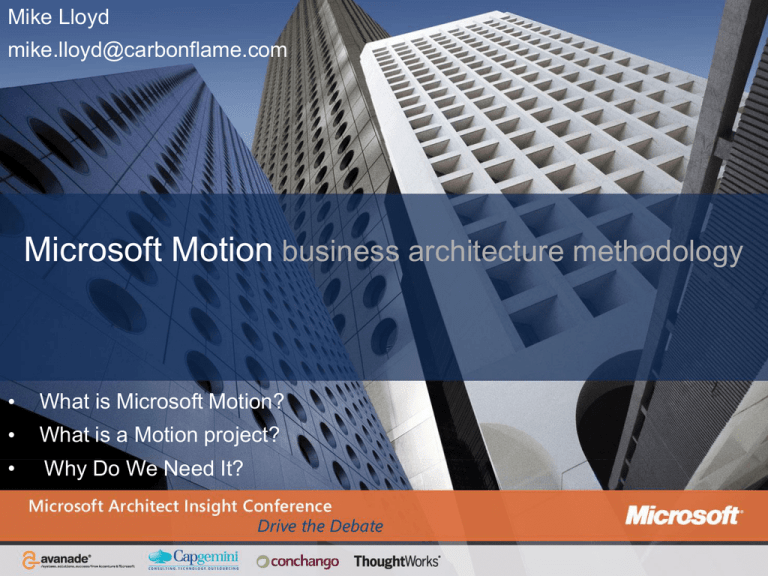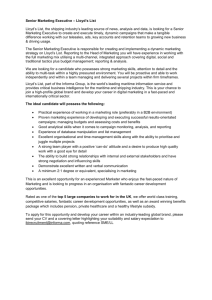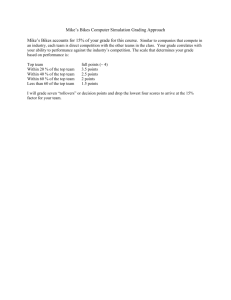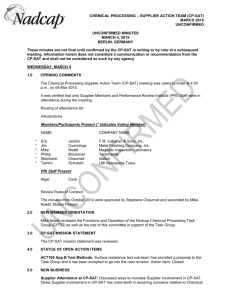MET0102 AIC Motion 6 WORDS
advertisement

Mike Lloyd mike.lloyd@carbonflame.com Microsoft Motion business architecture methodology • What is Microsoft Motion? • What is a Motion project? • Why Do We Need It? Devices @ Wireless Voice Web Svcs Email Mail External web services B2B Common presentation logic Web Svcs Web Svcs Enterprise Integration Hub Web Svcs Web Svcs Content Mgt Document Mgt. Commission Adviser tools Sales Mgt Contact Mgt Agent Admin Segmentation Customer Admin Outputs Ops Mgmt Workflow Diary Mgr Process Mgt Business Rules Security Infrastructure services Campaign Mgt Business services What Does the Business Want IT to Do? • Understand the business better • But org charts and process maps don’t cut it • Respond a little faster • But IT rarely gets funding for resilient, flexible solutions • Cost a little less • … or create more value • Help make a difference • Invoke IT as an enabler for effective business change • Identify powerful leverage points for the application of IT Describing the Business Defining the Business 1. Business capabilities are stable 2. Capabilities that don’t add value can be eliminated 3. IT is a powerful agent for transformational change Web services SOA Motion Mike Lloyd mike.lloyd@carbonflame.com What is Microsoft Motion? Microsoft Motion Business Architecture Modelling Customer-facing channel partners 2. Generate demand 5. Collaborate 3. Fulfil demand IT providers 4. Plan and manage Business partners Customers 1. Develop product or service Financial service providers The Basic Module Map Customer-facing channel partners 1. Develop product or service 2. Generate demand 5. Collaborate Customers 3. Fulfil demand IT providers 4. Plan and manage the business Financial service providers Business partners Module Map – Business Capabilities Customer-facing channel partners 1. Develop product or service 2. Generate demand 5. Collaboration 3. Fulfil Demand 3.3 Procure resources 3.3.1 Sourcing and Supplier Contract Management 3.3.2 Purchasing 3.2 Advanced Planning Request Resources Manage Requisition Approva Processl Create Purchase Requisitions Acquire/Purchase Choose or Default Supplier for Goods IT providers Verify/ Negotiate Price Purchase Indirect Materials Purchase Outside Vendor Services Manage Automatic Replenishment Manage Purchasing Methods Consolidate Approved Requisitions by Supplier Purchase Capital Goods Manage Open to Buy/Blanket POs Create Purchase Orders Track Supplier Commitments Track Open POs Approve & Validate Contract Payments Provide Supplier Self-Help Maintain Supplier Catalog Request Resources Purchase Direct Materials & Supplies Manage Suppliers Manage Supplier Relationships 3.5 Logistics Create Auction Bids Resources Manage Purchase Item Catalog Manage RFI/RFQ/ RFP process 3.4 Produce Product Perform Encumbrance Check Manage Buyer Performance Business partners Customers 3.1 Provide Service 4. Plan and manage the enterprise Create purchase requisitions Financial service providers The module map Anatomy of a Capability Platform Process People Encapsulating a Capability What Use is a Business Architecture Model? Value proposition Operating model Capabilities Partnerships Metrics IT project portfolio Outsourcing IT projects Offshoring SOA Self-service Mike Lloyd mike.lloyd@carbonflame.com How do you use Microsoft Motion? Why Start a Motion Project? Motion Business architecture Incremental change project Problem-solving Core vs. non-core Module map Customer-facing channel partners Acquisition 2. Generate demand 5. Collaborate 3. Fulfil demand IT providers 4. Plan and manage Financial service providers Business partners Sourcing Customers Consolidation 1. Develop product or service Governance and compliance Automation SOA Motion Project – Phase 1 Go/no-go? Phase 1 Establish Project Context Generate Level 2+ capability map Document project context & objectives Assess capability performance Gate 1 – Go, or no-go? Motion Project – Phase 2 Go/no-go? Check completeness of operational, environmental and financial framing Phase 2 Capture Business Architecture Gather existing business and financial documentation 'Go In' – Map relevant Level 2+ capabilities 'Go Up' – Connect capability Levels 1 and 2 'Go Out' – Connect environmental capabilities Gate 2: Check completeness Off-Ramp Motion Project – Phase 3 Go/no-go? Check completeness of operational, environmental and financial framing Understand 'as-is' business architecture Phase 3 Complete 'as-is' Business Architecture 'Go Down' – Cross-reference capabilities to teams, business objectives and financials Identify capability connectors Identify service level expectations Identify people, process and platform views Workshop: Gate 3 – Understand Business Architecture Off-Ramp Motion Project – Phase 4 Go/no-go? Check completeness of operational, environmental and financial framing Understand 'as-is' business architecture Phase 4 Recommend Next Steps Identify leverage points and impediments Select appropriate improvement model Develop next step recommendation Identify project opportunities and risks Deliver final project recommendation Deliver final project recommendations Case Study • Situation • Fortune 500 logistics company • Comprises five independently-minded business units • IT wanted to move to SOA, business saw little benefit • Project • Senior executive wanted to expose commonalities across LoB • Eight week Motion project sponsored • Result • Business thought there was ~15% overlap between LoB; actually ~60% • Businesses now communicating with a common language • 20% sustainable reduction in CIO’s CapEx • Management has a clear path to adopt SOA • Motion rolled out to all departments as operating model & strategy Mike Lloyd mike.lloyd@carbonflame.com Microsoft Motion business architecture methodology Next steps … Workshop – this afternoon, 1pm Panel discussion – tomorrow, 3pm






